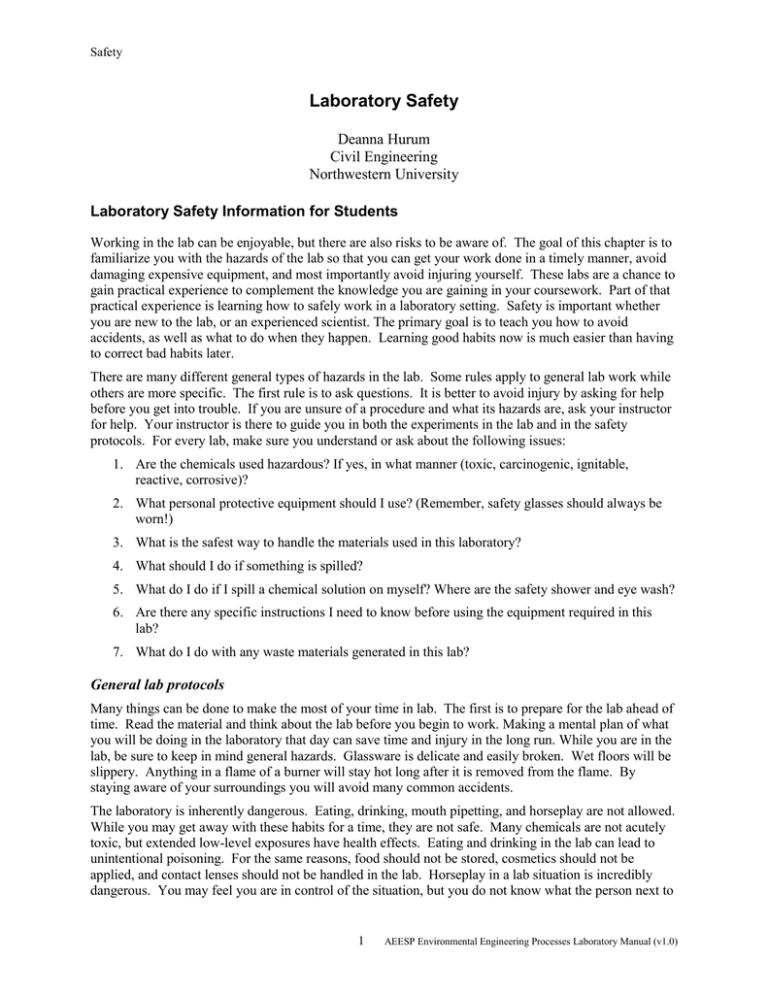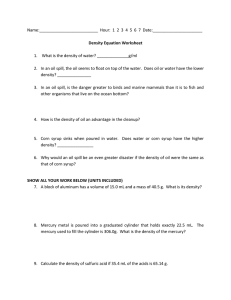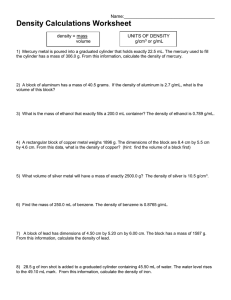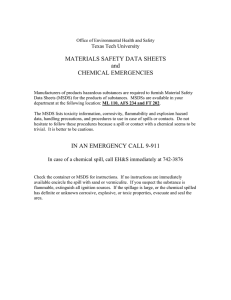Laboratory Safety
advertisement

Safety Laboratory Safety Deanna Hurum Civil Engineering Northwestern University Laboratory Safety Information for Students Working in the lab can be enjoyable, but there are also risks to be aware of. The goal of this chapter is to familiarize you with the hazards of the lab so that you can get your work done in a timely manner, avoid damaging expensive equipment, and most importantly avoid injuring yourself. These labs are a chance to gain practical experience to complement the knowledge you are gaining in your coursework. Part of that practical experience is learning how to safely work in a laboratory setting. Safety is important whether you are new to the lab, or an experienced scientist. The primary goal is to teach you how to avoid accidents, as well as what to do when they happen. Learning good habits now is much easier than having to correct bad habits later. There are many different general types of hazards in the lab. Some rules apply to general lab work while others are more specific. The first rule is to ask questions. It is better to avoid injury by asking for help before you get into trouble. If you are unsure of a procedure and what its hazards are, ask your instructor for help. Your instructor is there to guide you in both the experiments in the lab and in the safety protocols. For every lab, make sure you understand or ask about the following issues: 1. Are the chemicals used hazardous? If yes, in what manner (toxic, carcinogenic, ignitable, reactive, corrosive)? 2. What personal protective equipment should I use? (Remember, safety glasses should always be worn!) 3. What is the safest way to handle the materials used in this laboratory? 4. What should I do if something is spilled? 5. What do I do if I spill a chemical solution on myself? Where are the safety shower and eye wash? 6. Are there any specific instructions I need to know before using the equipment required in this lab? 7. What do I do with any waste materials generated in this lab? General lab protocols Many things can be done to make the most of your time in lab. The first is to prepare for the lab ahead of time. Read the material and think about the lab before you begin to work. Making a mental plan of what you will be doing in the laboratory that day can save time and injury in the long run. While you are in the lab, be sure to keep in mind general hazards. Glassware is delicate and easily broken. Wet floors will be slippery. Anything in a flame of a burner will stay hot long after it is removed from the flame. By staying aware of your surroundings you will avoid many common accidents. The laboratory is inherently dangerous. Eating, drinking, mouth pipetting, and horseplay are not allowed. While you may get away with these habits for a time, they are not safe. Many chemicals are not acutely toxic, but extended low-level exposures have health effects. Eating and drinking in the lab can lead to unintentional poisoning. For the same reasons, food should not be stored, cosmetics should not be applied, and contact lenses should not be handled in the lab. Horseplay in a lab situation is incredibly dangerous. You may feel you are in control of the situation, but you do not know what the person next to 1 AEESP Environmental Engineering Processes Laboratory Manual (v1.0) Safety you is doing. This situation can inadvertently cause injury. The lab is an informal chance for hands-on learning, but it is not a playground. There will be safety equipment available in the lab. Take full advantage of this equipment. Safety glasses, lab coats, and gloves are for your protection. Your vision is far to valuable to risk not using safety glasses. Prescription eyeglasses are not a suitable substitute for safety glasses, and there are many options that fit over prescription glasses. Whenever you are in the lab you should be prepared with either safety glasses or goggles. The lab coat should be worn only in the lab to protect your clothing. When you are finished with the lab, remove the coat before leaving the room to prevent spreading contamination outside the laboratory. Gloves will be provided to prevent contact of chemical or biological agents with your hands. There are a wide variety of gloves for different purposes, but the most commonly used are disposable latex gloves. These are good general-purpose gloves that should protect your hands from the majority of agents used in the labs. However, latex allergies are quite common and if you know you have one, please alert your instructor. There are many suitable replacements that do not contain the allergens present in latex. Additionally, there are many situations in the lab for which latex is not the best option. For example, phenol is commonly used in microbiology, but it also permeates latex quickly, making the glove useless as protection from phenol exposure. If you have questions, there are resources to check regarding the best glove for a given use (1). Please remember that gloves only slow the rate of exposure to chemicals, they do not always prevent exposure. Avoid contact with chemical solutions, even with gloves on. If the outside of the gloves get splashed, you should remove those gloves and don clean ones as soon as possible. In addition to the protective clothing available in the lab, please come to lab in appropriate dress. Shorts and sandals are not appropriate at any time. Wear substantial shoes that cover your foot. This way if anything spills to the floor your feet are protected. In general, you want the least amount of exposed skin possible. Clothing acts as an absorbent protector for your skin. When you are finished with the experiment, clean your glassware immediately. Soap and water followed by distilled water is good for general cleaning. Please use caution when handling the wet glass. If you do break glass in the sink, use care in cleaning the sharp broken shards. Broken glass should be disposed of in a separate container from normal trash. If acid washing is required, please follow directions given to you by your instructor. The acid used in an acid bath is very concentrated and dangerous. It is critically important that you wear your lab coat, heavy-duty gloves, and safety goggles for this cleaning step Before you leave the lab, be sure to thoroughly wash your hands. Hand washing prevents the spread of biological and chemical contaminates and protects you from accidental exposure. There are many good commercial anti-bacterial soaps that both clean and disinfect your hands. Even if you wear gloves, this simple step should not be skipped. Chemical Safety Acids and Bases: There are risks involved in working with any chemical, even water. You should take some time to familiarize yourself with these risks before performing your lab experiment. Some of the most common reagents you will use are acids and bases. Do not mix acids and bases unless you are instructed to do so. The reaction of the two together can release a lot of heat and cause damage. Always dilute acids or bases by adding them to water. If you add water to a concentrated acid the heat released can cause an explosion, spreading acid throughout a room. A simple, albeit silly, way to remember this is that you should “add acid to water as you ought-er.” Adding the acid or base to the larger volume of water allows the heat to dissipate safely. 2 AEESP Environmental Engineering Processes Laboratory Manual (v1.0) Safety In case of spills: Acid spills should be neutralized with sodium bicarbonate and then cleaned up with a paper towel or sponge. Do not use a strong base, such as sodium hydroxide, to neutralize a strong acid like hydrochloric acid. The sodium bicarbonate will do the job with much less chance of injury. Base spills should be neutralized with boric acid and then cleaned with a paper towel or sponge. Do not use acetic acid or sodium bicarbonate to clean a base spill. The sodium bicarbonate will not neutralize the spill, and acetic acid could react strongly with the base. If you spill an acid or base on your skin, immediately wash well with water. Strong bases react with the oils in your skin to produce a soapy feeling layer. Rinse until well after that feeling is gone. Do not attempt to neutralize a spill on your skin. It can potentially make the injury worse. It is possible that you will be using mercury during these labs. Mercury is commonly found in thermometers and various instruments. If you do have a mercury spill, clean it up immediately with either a commercial product such as Resisorb ™, Hg Aborb ™ or elemental sulfur. Mercury sponges may also be purchased which form an amalgam with the liquid mercury, trapping it on the surface of the sponge. Mercury is quite volatile even small droplets can cause significant exposure. Be sure to thoroughly clean after a spill. The health affects of mercury are well established and contact with the metal should be minimized. Reagents and Hazardous Waste: When you are getting reagents, never put anything directly into the stock bottle. This could contaminate your stock supply. Instead, pour a small amount into a beaker or clean weigh dish. Once you have added a chemical to a container, label it promptly. When you are finished with the experiment, dispose of the excess chemical as chemical waste. Do not simply pour the excess chemical down the sink. This is a bad habit that is potentially dangerous. The drains of the sinks should not become extra-curricular chemical experiments! Your instructor can help you safely dispose of the chemicals. Biological Safety If you are working with water that may be contaminated with bacteria, or with specific bacterial cultures you should follow some additional laboratory practices. Treat all cultures as if they contain pathogens. When you are done with the experiment, be sure to disinfect the area where you were working with a solution of 1:10 diluted household bleach. Commercial disinfectants may also be used. Used petri dishes, pipettor tips, pipets, and other disposable items that come into contact with bacteria should be sterilized before disposal. Ask your instructor where the biological waste should be deposited prior to sterilization. If you spill water that contains bacteria, clean the area before disinfecting and dispose of the paper towels and gloves as biological waste. Again, even though you are wearing gloves, wash your hands thoroughly before leaving the lab. Many biological techniques will require you to sterilize loops and spreaders by “flaming.” This is done by dipping the tool into ethanol and then burning off the ethanol in the flame of a burner. There are several hazards here. Ethanol is flammable and you should be very careful when you are working with it near an open flame. If you do ignite your ethanol, promptly cover it with a watch glass to suffocate the flame. Alternatively, you may put out the flame with water. Once you have sterilized your loop, be sure not to touch the end that was in the flame. It will still be hot, and you will also contaminate your freshly cleaned loop. 3 AEESP Environmental Engineering Processes Laboratory Manual (v1.0) Safety Compressed Gas Safety In this course, you may have occasion to use compressed gasses. Cylinders are dangerous and if damaged behave like missiles. This danger is similar to the small CO2 cartridge that has the power to lift a model rocket if it were many orders of magnitude larger. A damaged gas cylinder has the power to penetrate cement walls. Never move a cylinder without your instructors help. Cylinders should be chained at all times to prevent them from falling and being damaged. The regulator on a cylinder has fittings that are specific to the type of gas being regulated. Never modify a regulator to make it fit on a cylinder. Many regulators are incompatible with gasses other than those specified. For example, a regulator once used with hydrogen should never be used with oxygen due to the risk of explosion. Over time, regulators used with hydrogen may develop a coating of metal hydrides inside. When put under pressure with oxygen they can spontaneously explode. Similar hazards exist when a compressed air regulator is used on an oxygen tank. Oil from the compressed air can settle in the regulator, when it is exposed to oxygen it may explode. The safety inherent in the different fittings is critical in preventing accidents. Do not override this safety factor. The first time you use a compressed cylinder, ask for help from your instructor. The basic instructions follow. To operate the regulator, first ensure that the pressure-adjusting knob (the big knob in the center of the regulator) is turned counter-clockwise and loose. Open the cylinder valve until the pressure is registered on the first gauge on the regulator. Do not stand directly in front of the regulator while you do this to protect yourself in case of regulator failure. Turn the pressure-adjusting knob clockwise to allow flow through the regulator. The second gauge will measure the pressure that is passing through the regulator. A final needle valve on the regulator can be used for fine control of the flow. To turn off a regulator, first close the valve at the cylinder. Next, vent the system so that there is no pressure in the regulator. Finally, loosen the pressure-adjusting knob until it turns freely. 4 AEESP Environmental Engineering Processes Laboratory Manual (v1.0) Safety Laboratory Safety Information for Instructors This section is intended to serve as a reference collection of sources of information, not as answers to every safety question. There is a large amount of information available, and some general information is summarized here. Many details are left out for the sake of brevity. Early in the course, the students should be told the location of safety equipment within the lab, such as safety showers, eyewash stations, and first aid kits. The students and instructors should know the location of these items before an emergency occurs so they don’t have to waste valuable time looking for them. If time and resources permit, there are several short safety films that are distributed free of charge by the Howard Hughes Medical Institute. These films are a good way to illustrate general chemical and biological safety practices. Personal Protective Equipment Gloves, safety glasses, and lab coats are basic lab safety equipment. Lab coats offer protection for clothing and additional protection to skin for general lab use. There are many options, but a basic cotton coat is the most common and versatile choice. Eye protection comes in many styles and grades. General purpose safety glasses should be appropriate for teaching labs. Choosing appropriate gloves can be the most difficult task. Gloves that offer protection for one task may be dangerous for another. Many sources provide tables of different glove materials and the protection they provide from different chemicals (1). The manufacturer or distributor of a particular glove will often provide this information for several glove types within their catalog. If latex allergies are a concern, nitrile gloves are an allergen free substitute with many of the same properties as latex. Chemical Safety Material Safety Data Sheets The first place to look for information about a specific chemical is its Material Safety Data Sheet (MSDS). Please keep in mind that these forms are written for the legal protection of manufacturer and even relatively safe compounds, such as sodium chloride, have sheets that indicate extreme caution. Do not let this deter you. There is useful information in these warnings and they are there for safety, not to frighten. There are several repositories of MSDS’s. The manufacturer is required by law to provide an MSDS when you order a chemical. It’s a good idea to keep a reference file for the lab as the chemicals come in. In addition, most manufacturers keep a public MSDS database on their web page. Sigma, Fisher, VWR, and Hach each have public web access to their MSDS databases. There are also several good web sites that contain access to MSDS and other safety information. One very useful site is hazard.com. This site contains a large MSDS collection and links to many other safety sites. When you read an MSDS there are several useful sections. The first, and most useful, will be a general overview of the compound’s hazards. Exposure limits, chemical properties, and reactivity are described on the first page. This information gives a general idea of how the chemical should be handled and stored. Often there are references to specific studies on the health effects of the compound as well. Chemical Storage Chemicals should not be stored in the lab haphazardly. Many chemicals are incompatible with others and improper storage can be quite dangerous. Detailed information on chemical compatibility can be found in several print sources (3-4) and online. Often incompatibilities are listed on a compounds MSDS. In general, acids should be stored with other acids and away from bases and organic compounds. Organic acids, such as acetic acid should not be stored with mineral acids. Bases should be stored with bases and 5 AEESP Environmental Engineering Processes Laboratory Manual (v1.0) Safety away from acids and organic compounds. Organic compounds and inorganic compounds should be stored separately as well. Many compounds have specific storage requirements and these are often listed on the label. Acid washing Acid washing is by its nature a dangerous task. Older texts will give instructions on how to make a chromic acid bath to clean glassware. Do not follow these texts! Chromic acid is dangerous as an acid, as a toxin, and as a carcinogen. There are substitutes available that clean just as well without the toxic and carcinogenic effects. These substitutes are still quite dangerous as they are strong acids, but the eventual disposal does not carry the same hazards as chromic acid does. One such product is Nochromix™, which is available from a variety of general lab suppliers. However, the reduction in the health hazards does not warrant any changes in the handling of the acid bath. Sturdy neoprene gloves, protective goggles, and a neoprene apron should be worn for protection. If possible, the acid bath should not be moved. A sturdy covered polyethylene pan in a hood with a sink is optimal. Mercury Spills The most common source of mercury in a teaching lab is a broken thermometer. Once a thermometer has been broken, quick and thorough clean up is required. Mercury is quite volatile and the health effects are not trivial (5). There are several commercial products for absorbing mercury, but the easiest solution is to replace mercury where possible. Several companies now provide NIST certified thermometers, which are based on a non-toxic oil instead of mercury. Clean up of these thermometers is much easier and the health hazards are minimal. If it is an option, consider replacing the mercury thermometers. Another hazard of mercury spills, though not a health issue, is its ability to form amalgams with other metals. This can be useful when cleaning a spill with a mercury spill pillow, but it can also be detrimental to any jewelry that may come into contact with the mercury. If appropriate, it may be worthwhile to warn the students of this risk. Chemical Spill Cleanup and Waste Disposal A wide range of methods can be used to clean up spills (6). The most common spills are acid and base spills, which should be cleaned up as described in the student section. If large quantities of concentrated acids and bases will be used, commercial spill pillows are convenient ways to contain the spill and collect it for disposal. There are many local regulations regarding chemical waste disposal. Many universities have safety offices that can guide you on how to best collect the waste from the lab and the preferred disposal method. Very few chemical solutions can simply be flushed down a sink. Know the waste disposal methods for your area and be sure the students learn to follow them. Biological Safety While a large number of disinfectants are now available, household bleach is still one of the most economical. Be sure that at the end of each lab where biological agents are used the benches are thoroughly cleaned and disinfected. Many pathogens can be present in environmental samples and they should be treated as such. The waste from these labs should also be treated as a biological hazard and should be sterilized before disposal. This can most easily be done with an autoclave, but other methods may also be used (7). 6 AEESP Environmental Engineering Processes Laboratory Manual (v1.0) Safety Compressed Gasses Gas cylinders are inherently dangerous and often overlooked. Whenever a cylinder is moved the regulator should be removed the protective cap replaced. Always move a cylinder on a chained cart designed for this purpose. Never open a tank without a regulator! This is very dangerous. The fittings for gas cylinders are specific to the type of compressed gas. Flammable gasses, such as acetylene and hydrogen use fittings that are reverse threaded. This is indicated by an indented dash on the fitting. Detailed information on regulator types and their function can be found elsewhere (8). Once a cylinder is in place it should be secured so that it cannot tip. This is often done with either a chain or strap, but floor mountings are also available. Once the regulator is on the gas cylinder it should not be moved. Some compressed gasses require special caution. Acetylene tanks should never be plumbed with copper tubing. The copper can react with the acetylene forming a shock sensitive explosive. Acetylene is sold dissolved in acetone in a clay matrix. It is important to not use the acetylene until it is at so low a pressure that acetone is removed from the cylinder. It is important to check any compressed gas cylinder for leaks once the regulator is installed and acetylene is no exception. A soapy water solution works well. Check the fittings for bubbles after opening the cylinder. Keep in mind that the valve on the tank itself may have leaks. If this is the case, immediately return it for a replacement. A leak at a cylinder valve is inherently dangerous. References 1) The Chemical Protective Clothing Performance Index Book, John Wiley and Sons, 1989. 2) Safe Storage of Laboratory Chemicals , Pipitone, D.H. ed., John Wiley and Sons, 1984. 3) Prudent Practices for Disposal of Chemicals from Laboratories, Committee on Hazardous Substances in the Laboratory, et al. National Academy Press, 1983. 4) Mercury Study Report To Congress, Volume V: Health Effects Of Mercury And Mercury Compounds. U.S. Environmental Protection Agency. 1997. 6) Reagent Chemicals MCB Manufacturing Chemists, Inc. 1981, pp 359-402. 7) Biosafety in Microbiological and Biomedical Laboratories, US Health and Human Services Publication No. CDC93-8395, CDC-NIH, 1993. 8) Guide to Safe Handling of Compressed Gases, Matheson Gas Products, Inc. 1983. 7 AEESP Environmental Engineering Processes Laboratory Manual (v1.0) Safety Other Useful References Web Sites Howard Hughes Medical Institute: http://www.hhmi.org/ Safety Information Resources, Inc. www.hazard.com American Chemical Society, Chemical Health and Safety Division: http://tungsten.acs.org/health.html http://chas.cehs.siu.edu/ Occupational Safety Health Association: www.osha.gov Environmental Protection Agency: www.epa.gov Centers for Disease Control: www.cdc.gov National Institutes of Health: www.nih.gov Reference Books Standard Methods for the Examination of Water and Wastewater, American Public Health Association, 1995 CRC Handbook of Laboratory Safety. (A. Keith Furr, ed.). 5th ed.: CRC Press, 2000. Laboratory Biosafety Manual. Edition: 2nd ed.: World Health Organization, 1993. 8 AEESP Environmental Engineering Processes Laboratory Manual (v1.0)







